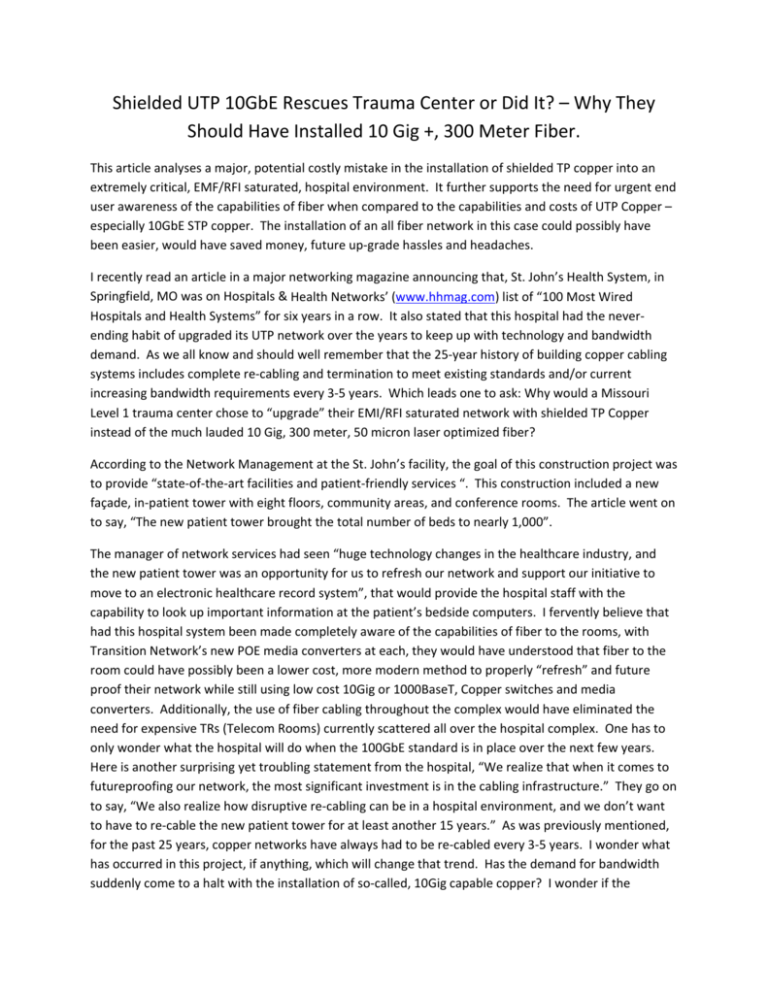Shielded UTP 10GbE Rescues Trauma Center or Did It? – Why
advertisement

Shielded UTP 10GbE Rescues Trauma Center or Did It? – Why They Should Have Installed 10 Gig +, 300 Meter Fiber. This article analyses a major, potential costly mistake in the installation of shielded TP copper into an extremely critical, EMF/RFI saturated, hospital environment. It further supports the need for urgent end user awareness of the capabilities of fiber when compared to the capabilities and costs of UTP Copper – especially 10GbE STP copper. The installation of an all fiber network in this case could possibly have been easier, would have saved money, future up‐grade hassles and headaches. I recently read an article in a major networking magazine announcing that, St. John’s Health System, in Springfield, MO was on Hospitals & Health Networks’ (www.hhmag.com) list of “100 Most Wired Hospitals and Health Systems” for six years in a row. It also stated that this hospital had the never‐ ending habit of upgraded its UTP network over the years to keep up with technology and bandwidth demand. As we all know and should well remember that the 25‐year history of building copper cabling systems includes complete re‐cabling and termination to meet existing standards and/or current increasing bandwidth requirements every 3‐5 years. Which leads one to ask: Why would a Missouri Level 1 trauma center chose to “upgrade” their EMI/RFI saturated network with shielded TP Copper instead of the much lauded 10 Gig, 300 meter, 50 micron laser optimized fiber? According to the Network Management at the St. John’s facility, the goal of this construction project was to provide “state‐of‐the‐art facilities and patient‐friendly services “. This construction included a new façade, in‐patient tower with eight floors, community areas, and conference rooms. The article went on to say, “The new patient tower brought the total number of beds to nearly 1,000”. The manager of network services had seen “huge technology changes in the healthcare industry, and the new patient tower was an opportunity for us to refresh our network and support our initiative to move to an electronic healthcare record system”, that would provide the hospital staff with the capability to look up important information at the patient’s bedside computers. I fervently believe that had this hospital system been made completely aware of the capabilities of fiber to the rooms, with Transition Network’s new POE media converters at each, they would have understood that fiber to the room could have possibly been a lower cost, more modern method to properly “refresh” and future proof their network while still using low cost 10Gig or 1000BaseT, Copper switches and media converters. Additionally, the use of fiber cabling throughout the complex would have eliminated the need for expensive TRs (Telecom Rooms) currently scattered all over the hospital complex. One has to only wonder what the hospital will do when the 100GbE standard is in place over the next few years. Here is another surprising yet troubling statement from the hospital, “We realize that when it comes to futureproofing our network, the most significant investment is in the cabling infrastructure.” They go on to say, “We also realize how disruptive re‐cabling can be in a hospital environment, and we don’t want to have to re‐cable the new patient tower for at least another 15 years.” As was previously mentioned, for the past 25 years, copper networks have always had to be re‐cabled every 3‐5 years. I wonder what has occurred in this project, if anything, which will change that trend. Has the demand for bandwidth suddenly come to a halt with the installation of so‐called, 10Gig capable copper? I wonder if the installation of shielded twisted pair copper in this new “future‐proofed”, ultra‐modern project has just become another walk along the same copper path to insanity – doing the same thing over and over again expecting different results. Back when St. John’s started designing the “new” copper infrastructure and was worrying about overcoming the alien/UFO crosstalk that currently plagues 10Gig copper networks, they should have considered a complete fiber network as there is no such problem. It is true that in Europe, STP Copper is commonly used to combat EMI/RFI maladies in the network. However, here in the United States we tend to be a bit more proactive when it comes to new and innovative technology. Therefore using shielded copper cabling as a method to combat this problem is not only extremely expensive, but it also requires the use of expensive connectors, patch panels and requires a grounding system that far exceeds that required of an all fiber network. As a matter of fact, fiber is immune to any EMI/RFI problems, requires testing for loss, and, in some cases length. Fiber is also all dielectric (does not conduct electricity) and requires no grounding whatsoever. No alien cross talk problems to deal with here. Also, the labor and man hours associated with the installation and testing of an STP Copper network far exceeds that of a fiber network. As we all know, all hospital environments are saturated with EMI/RFI as well as other forms of electrical interference which is more reason to install fiber with inexpensive media converters where required to support in‐room data acquisition activities. The hospital’s existing TRs (Telecom Rooms) would have essentially disappeared. VOiP could have been used easily with the fiber and the old 66/100 Blocks to support telephone cross connections would have gone away completely. Additional savings would have been accomplished because no switches of any form would have been required in these telecom rooms. There would have been reduced points of network failure, no required power at the TR, no grounding at the TR, no lights required in the telecom rooms, and no HVAC equipment would have been required to keep the switches cool because there would have been no switches. Security would have been at a maximum as the entire group of network switches supporting the hospital would have been in a centralized location in the MDF (Main Distribution Frame) and not scattered around the complex. It is well known that the cost of the power to maintain a copper switch is substantially higher than that required of a fiber switch. If every telecom room has one, or two, or three copper switches, then the cost just to power them will be enormous. With a pure FTTD network, TR switches ARE NOT required. The hospital could have saved at least 2% per year per telecom room because no electrical power would have been required to support them. Further, the additional space now available in the TR could have been used for storage of hospital equipment and/or records. Considering cabling space, the use of 10Gig, 50/125 micron would have consumed much less space in the overhead and cable trays. According to the article, the hospital did, in fact, use 50 micron, LOF from the MDF to the Telecom Rooms. I trust they used 144 (or larger) OFNR/OFNP to do the job with fusion spliced pigtails at each end. Space is certainly a premium in all building infrastructures as cable trays/ladders, overhead areas, walls, etc., become crowded almost immediately when installing any type of network cabling. The Main Distribution Frame (MDF) is always run amuck with all types of cable. The fiber solution also saves space and is easier to install as the Shielded Copper product, in most cases, has a much larger diameter and is less flexible than the typical 6 or 12 fiber distribution cables. One 144 fiber riser cable which supports 72 users is .97 inches in diameter. The use of plenum inner duct, which is a common costly mistake in most fiber networks, would have been unnecessary in most areas of the complex thus saving the hospital even more money on the installation. The total time to install the fiber network would have been 1/3‐1/2 the time it takes to install a typical copper network. Therefore the staff could have been on line and functioning long before the copper network had been installed, terminated and tested. Testing of the fiber network would have consisted of only two tests: Loss and possibly distance. The OM‐3, 50 micron fiber is certified to 10Gig at 500 meters with LAN based DWDM capabilities for future upgrades. In many cases, the distances never would have reached the 300 meter maximum which is the installed limit per industry standards – not the maximum capability of 50 micron LOF. Therefore the distance test may not have been necessary thus further decreasing the testing time and cost of the fiber network. It is important to keep in mind that new electronics will allow OM‐3 fiber to operate at much higher bandwidth now and in the future. Have you ever heard of LAN Based DWDM? This fantastic technology will allow for up to 100Gig over existing OM‐3 fiber networks – a limit that is far beyond the reach of any known copper cable. If OM‐3 fiber would have been used throughout this hospital complex, future upgrading of the network would have consisted of changing only the electronics and not the reinstallation of the infrastructure. I repeat: The use of fiber to the bed and desk would have required only the change of electronics at each end of the cable when the demand for bandwidth increased or the standards changed in the future. A network is only as good as its weakest link. The weakest link in this case, unfortunately, is the copper cabling. Data networking history has proven that for the past quarter century copper networks have required upgrading every 3 to 5 years just to keep up with the demand for bandwidth and technology. I would assume the plan for “future proofing” this network did not include a thorough study of the US Courts South Texas project where 9 court houses in 7 cities were properly “future proofed” using 10Gig, LOF instead of legacy copper. The US Courts, South Texas networking staff educated themselves properly on the capabilities of fiber and compared that knowledge to their 25 year experience with copper cabling. They made the decision to use fiber based on this knowledge. They did the job themselves, saved thousands of dollars, eliminated the copper, eliminated expensive and bothersome network maintenance, eliminated the embarrassment of installing legacy cabling, and most importantly, eliminated the need to re‐cable any time in the foreseeable future. To increase their network’s capabilities they now have only to change electronics at either end of the fiber. No more re‐cabling, no more hassles and no more network outages due to the copper infrastructure’s inability support the required bandwidth. They used basic tools, basic test equipment, current fiber networking knowledge instead of myths, and built the largest OM‐3 fiber to the desk installation in the United States. Fiber – Install it, test it, and forget it! ‐‐‐ Bob Ballard, RCDD, CFOI, Owner









